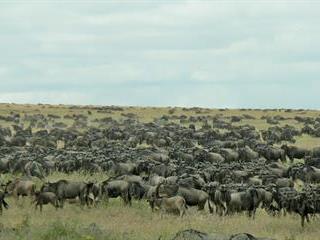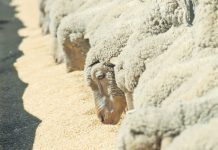
Holistic planned grazing (HPG), or high density grazing, refers to the livestock management aspect of holistic management (also called the Savory approach or holistic resource management). It is a practice in which the activities of masses of free-moving herds are mimicked in order to better manage domestic livestock for productive and sustainably managed rangelands.
Essentially, HPG is a type of adaptively managed, time-controlled rotational grazing. The time that animals spend in any camp is based on a grazing plan, as well as on actual forage offtake (usually 50% to 70%). The number of days before animals return to a camp is based on plant recovery of biomass, depending on rainfall in the area and season.
Why mimic the masses?
The world’s great rangelands were once inhabited by millions more grazing and browsing herbivores than today. Mass slaughter in the 19th and 20th centuries reduced these numbers drastically. Game, such as antelope, moved periodically at high densities during mass migrations, or when bunched to protect themselves from predators. Their passage appeared destructive, with forage being eaten or trampled, and soil being disturbed.
However, disturbance stimulates certain plants to germinate, and the long periods during which game were absent allowed recovery of plant biomass. Trampling by hooves also incorporates litter and excrement into the soil. This cycles mineral nutrients and organic matter, where the latter is known to improve soil water- holding properties.
HPG’s basic premise can be questioned, however, because herds do not move in this bunched way all the time, and not enough is known about herbivore numbers pre-1900 to determine what is ‘natural’.
Differing views
There are detractors and supporters in both popular and scientific literature. Articles in Farmer’s Weekly have argued for (see 16 and 23 January 2015 and 29 January 2016) and against (see 7 November 2014 and 26 February 2016) HPG, while renowned rangeland scientists have found evidence for (Richard Teague and colleagues) or against (John Carter and colleagues) high-density approaches.
This is nothing new; the same debate raged in the 1960s and 1970s and resurfaced after holistic management stalwart Allan Savory’s TED talk in 2013.
The varying conditions under which trials have been conducted is at least one reason for disparity. During farm-scale trials, certain aspects cannot be controlled, such as rainfall and temperatures year-on-year, droughts and local conditions of vegetation and soil. Certain aspects, such as management components of HPG, can be controlled, however. These include animal densities, camp and herd sizes at farm-relevant scales, and degree of supplementation.
Farmer and vet, Dr Peter Ardington, rightly said that research conducted with herds of fewer than 100 animals, or using densities of under 20 LSU/ ha, do not give high density approaches a fair trial (see FW, 16 January 2015). However, many trials have been conducted under farm-relevant conditions.
By measuring the relative difference between HPG performance and another grazing approach, it is possible to smooth out some of the differences that arise due to climatic, vegetative and soil variation. Grouping studies based on rainfall, animal densities and camp sizes, among others, can also untangle effects.
Forage utilisation
Over 100 data sets from the scientific literature – mostly from the Americas and Australia, with a few studies in Africa – were analysed from 1972 to 2016. We focused on cattle and found that HPG can significantly increase the utilisation of forage by cattle, compared with continuous and other rotational grazing approaches.
However, practitioners of high-performance grazing (similar to multi-paddock and deferred rotation grazing), as well as some researchers, criticise any reduction in an animal’s ability to select the most nutritious grasses, as this will likely negatively affect livestock weight gain, especially females during gestation and suckling.
HPG did not, on average, increase plant basal cover or plant production when compared with continuous or rotational grazing. There was also no effect on animal gain/ head. However, in some cases, gain/ ha was increased when compared with continuous grazing.
Such data must be interpreted with caution. The variability between studies is as interesting as the average result. The literature is missing a modelling approach to account for the interaction of multiple factors; climate, vegetation and exact management conditions matter.
Pasture response
Most studies examined grasslands, but a few included arid shrublands such as Karoo veld. When rainfall was less than 500mm/annum, HPG had negative effects on plant production (kg/ha). This is a warning to avoid making broad, sweeping statements advocating one approach over another. During his TED talk in 2013, Allan Savory claimed that holistic management could reverse climate change and desertification.
This declaration lacks caution because there is as yet no evidence to support it, as stated by Dr John Carter in Farmer’s Weekly of 26 February 2016.
According to agronomist Prof Lynn Sollenberger of the University of Florida in the US, HPG works on planted pastures in high rainfall areas, resulting in a 30% greater plant production and persistence of palatable species in 85% of studies. This makes sense in that disturbance stimulates early successional plant species from which pasture species are often bred.
Sources: Briske and colleagues ; Carter and colleagues, 2014; Savory, 2013; Sollenberger and colleagues, 2012; Teague and colleagues, 2011; and Tainton, 2013, Veld management in South Africa.
Email Dr Heidi Hawkins at [email protected] or [email protected]













